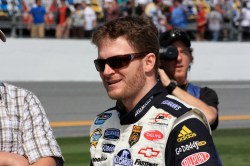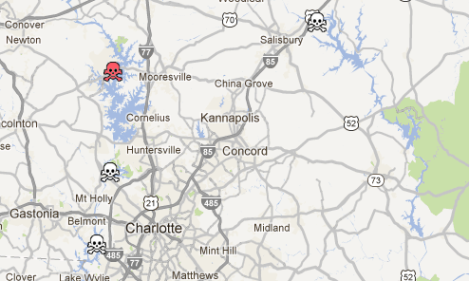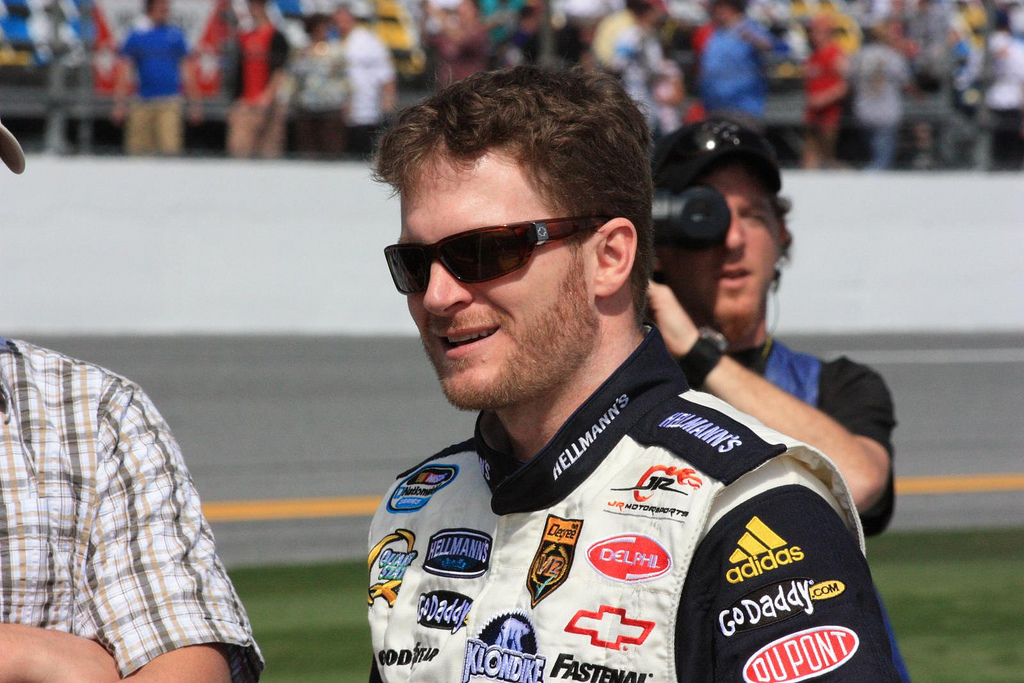NASCAR is not the most green sport in the universe, efforts to be more environmentally friendly notwithstanding. It’s dozens of cars whipping around a track, burning fuel as fast as possible to move pistons. Very few hippies attend races.
ThinkProgress assessed the sport’s environmental footprint last month. Their calculations suggest that one race uses 6,000 gallons of fuel, emitting 120,000 pounds of CO2. That’s in addition to the eight to 10 sets of tires each of the 40 teams use and the oil in the engines. Hell, until 2007, NASCAR used leaded gasoline. (To the sport’s credit, they are increasingly using slightly-more-environmentally friendly ethanol in their fuel.)

Dale Earnhardt Jr., surrounded by his mortal enemy. (Photo by Ted Murphy.)
Dale Earnhardt Jr. is one of NASCAR’s top drivers. He’s a legacy in the sport; his father was killed in a crash at Daytona in 2001. Over the course of his career, Junior (as he’s called) has raced 455 times — meaning he alone can be credited with about 1.36 million pounds of CO2 just on the track. And that’s not to mention the other emissions from burning fuel: particulates and contributors to smog. Dale Earnhardt Jr. is not exactly a champion of air quality.
But unlike most drivers, Junior really hates air quality. From Politico:
NASCAR driver Dale Earnhardt Jr. will be the new face of coal in a television ad touting the fossil fuel as a low-cost solution for power generation. …
“Most people think of me as a race-car driver, but I’m a business owner too,” Earnhardt says in the ad. “And at my company, the cars run on gas but the business runs on electricity. That’s why I’ve been learning about how coal keeps electricity prices down.” He suggests viewers visit [some website] to learn about “clean coal.”
The ad does not discuss Environmental Protection Agency regulations and makes no political statements.
Odd that a pro-coal group wouldn’t have a racecar driver include a nuanced, balanced discussion of the EPA’s attempts to limit air pollution! And that it would include a plug for “clean coal,” which, along with “the energy fairy” and “Casper the Friendly Ghost,” will soon solve all of our energy problems.
Junior’s advocacy, however well-intentioned, is disappointing. The health problems from coal power are legion. Take Kannapolis, N.C., a town northeast of Charlotte in Carrabus County. It’s where Junior is from. A map from the Sierra Club shows how close Kannapolis is to four coal-fired power plants. It’s surrounded by them, including one deemed a “biggest offender” nationally, in red on the map below.

Every year, that big offender, the Marshall plant, puts out 12 million tons of carbon pollution — and massive quantities of particulates and other pollutants that cause a number of health problems, including asthma. The link between coal power and asthma is strong, which may explain why Carrabus County is in the top third in the state when it comes to the asthma rate for children under the age of 15. And North Carolina is doing comparatively well when it comes to asthma. Many more states are not so lucky.
Junior never signed up to be a spokesperson for dirty air. He just wants to drive fast and make a little extra cheddar by doing spokesman work for what he sees as a small business issue. We get it. He’s wrong, but we get it. He doesn’t mean to advocate for dirty air in everything he does. He is just trying to help.
And Lennie didn’t mean to kill that puppy.



